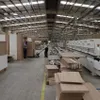Logistics enterprises face pressure to "go green"

The time has come for Vietnamese logistics businesses to quickly improve infrastructure, increase the conversion to environmentally friendly means of transportation, and enhance connectivity to promote the development of green logistics network in Vietnam.
Resolve problems early
Developing green supply chains, including green logistics, is almost mandatory if businesses do not want to be eliminated from global business, trade and import-export activities.
Many large logistics enterprises in the world, such as shipping lines and seaport enterprises, have a roadmap to reduce greenhouse gas emissions and convert to green energy earlier than the roadmap committed by countries. But in Vietnam, this process is still slow due to many barriers and challenges.
Accordingly, although the authorities have issued a mechanism for green supply chain development with a series of legal documents on all types of transportation, many experts believe that the process of implementing the regulations is in reality not very effective and has not created a competitive advantage in the field of import and export.
In addition, the Government's current regulations and policies on green logistics only focus on road transport.
Limiting regulations related to other logistics infrastructure such as warehouses or information technology systems has led to a lack of uniformity in the application and implementation of green logistics and a lack of connectivity, thus causing Vietnam's logistics costs to be higher than many countries in the region.
According to some experts, due to the limited awareness and understanding of businesses, as well as financial resources, qualifications, and capacity, "greening" the logistics industry has not really received due attention.
Furthermore, green transformation for the logistics industry is still a difficult problem for businesses. Currently, small passenger transport vehicles have begun switching from using fossil fuels to renewable energy (electricity), however large cargo transport vehicles and ships cannot make the conversion yet due to the huge investment costs.
From a business perspective, Ngo Sy Hoai, Vice President and General Secretary of the Vietnam Timber and Forest Products Association (VIFOREST), said that the logistics industry really needs a change in "quality" to survive in the current context.
To encourage businesses, the Government needs to create more favourable conditions for trade, simplify administrative procedures, and create the highest conditions to support businesses in the process of digital and green transformation, associated with the target of net-zero greenhouse gas (GHG) emissions by 2050 that Vietnam committed to at COP 26.
Opportunities for businesses
Currently, Vietnam's transport service structure is not balanced and sustainable, with the proportion of road transport predominating over other forms of transport.
Greenhouse gas emissions from road transport are 21.95 times higher than those of air transport, 19.94 times higher than sea transport, and 245.49 times higher than rail transport.
According to the World Bank (WB), transportation activities in Vietnam emit more than 50 million tons of CO2 each year, with road transportation accounting for 85% of total emissions. These emissions are expected to increase by an average of 6-7% per year, and it is forecast that the transportation industry will emit up to 90 million tons of CO2 per year by 2030.
Therefore, businesses need to quickly change their perception of the concept of green logistics, to more effectively exploit inland waterway traffic, coastal roads.
This is also an opportunity to help businesses increase the volume of goods transported, save costs, optimise profits, and reduce emissions from vehicles into the environment.
Sharing about the green transformation process in logistics activities, Truong Tan Loc, Marketing Director of Saigon Newport Corporation, said that the unit is always a pioneer in business operations, transforming methods, and gradually changing customer habits.
Nguyen Quang Vinh, Vice Chairman of the Vietnam Confederation of Commerce and Industry (VCCI), affirmed that when businesses apply green logistics in their strategies in the long term, they will increase the number of customers, increase revenue, reduce costs, and improve competitiveness in the market towards sustainable and comprehensive development.
However, to achieve the above goals, the Government and relevant ministries and branches need to continue to consider more policies to encourage and promote businesses towards green logistics development, especially small and medium enterprises.
Among them, there are tax incentives, creating incentives and reducing costs for businesses, encouraging the use of energy sources to replace fossil fuels in road transport.
For businesses, applying environmentally friendly means of transport, optimising routes and warehouse management, improving energy efficiency, and greening logistics activities not only helps reduce the impact on environment but also brings significant economic benefits to businesses.
Tags:





